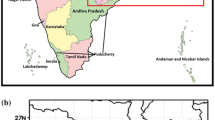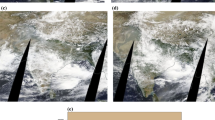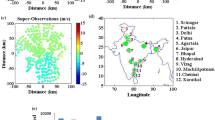Abstract
An attempt is made to evaluate the impact of Doppler Weather Radar (DWR) radial velocity and reflectivity in Weather Research and Forecasting (WRF)-3D variational data assimilation (3DVAR) system for prediction of Bay of Bengal (BoB) monsoon depressions (MDs). Few numerical experiments are carried out to examine the individual impact of the DWR radial velocity and the reflectivity as well as collectively along with Global Telecommunication System (GTS) observations over the Indian monsoon region. The averaged 12 and 24 h forecast errors for wind, temperature and moisture at different pressure levels are analyzed. This evidently explains that the assimilation of radial velocity and reflectivity collectively enhanced the performance of the WRF-3DVAR system over the Indian region. After identifying the optimal combination of DWR data, this study has also investigated the impact of assimilation of Indian DWR radial velocity and reflectivity data on simulation of the four different summer MDs that occurred over BoB. For this study, three numerical experiments (control no assimilation, with GTS and GTS along with DWR) are carried out to evaluate the impact of DWR data on simulation of MDs. The results of the study indicate that the assimilation of DWR data has a positive impact on the prediction of the location, propagation and development of rain bands associated with the MDs. The simulated meteorological parameters and tracks of the MDs are reasonably improved after assimilation of DWR observations as compared to the other experiments. The root mean square errors (RMSE) of wind fields at different pressure levels, equitable skill score and frequency bias are significantly improved in the assimilation experiments mainly in DWR assimilation experiment for all MD cases. The mean Vector Displacement Errors (VDEs) are significantly decreased due to the assimilation of DWR observations as compared to the CNTL and 3DV_GTS experiments. The study clearly suggests that the performance of the model simulation for the intense convective system which influences the large scale monsoonal flow is significantly improved after assimilation of the Indian DWR data from even one coastal locale within the MDs track.












Similar content being viewed by others
References
Abhilash, S, Das S, Kalsi SR, Das Gupta M, Mohankumar K, George JP, Banerjee SK, Thampi SB, Pradhan D. 2007. Impact of Doppler Radar Wind in Simulating the Intensity and Propagation of Rainbands Associated with Mesoscale Convective Complexes Using MM5-3DVAR System. Pure Appl. Geophys. 164:1491-1509.
Abhilash, S, A. K. Sahai, K. Mohankumar, John P. George, and Someshwar Das, 2012: Assimilation of Doppler Weather Radar Radial Velocity and Reflectivity Observations in WRF-3DVAR System for Short-Range Forecasting of Convective Storms, Pure Appl. Geophys. 169, 2047–2070.
Barker DM, Huang W, Guo Y-R, Xiao Q. 2004. A three-dimensional variational (3DVAR) data assimilation system for use with MM5: Implementation and initial results. Mon. Wea. Rev. 132: 897–914.
Daggupaty SM, Sikka DR. 1977. On the vorticity budget and vertical velocity distribution associated with a life cycle of monsoon depression. J. Atmos. Sci. 33:773-792.
Das S, Abhilash S, Das Gupta M, George JP, Kalsi SR, Banerjee SK, Thampi SB, Pradhan D, Mohankumar K. 2006. Assimilation of Doppler Weather Radar wind in a mesoscale model and their impact on simulation of thunderstorms and severe weather systems. Report no.NMRF/RR/01/2006, 120 pages, Published by NCMRWF, A-50, Sector-62, NOIDA, India 201 307.
Gao J, Xue M, Shapiro A, Droegemeier K. 1999. A variational method for the analysis of three-dimensional wind fields from two Doppler radars. Mon. Wea. Rev. 127, 2128–2142.
Govindankutty M, Chandrasekar A, Bohra AK, George JP, Das Gupta M. 2008. The Impact of Assimilation of MODIS Observations Using WRF-VAR for the Prediction of a Monsoon Depression During September 2006. The Open Atmospheric Science Journal. 2, 68-78.
Hong, S.-Y., J. Dudhia, and S.-H. Chen, 2004: A revised approach to ice microphysical processes for the bulk parameterization of clouds and precipitation. Mon. Wea. Rev., 132, 103–120
Janjic, Z. I., 1994: The step-mountain eta coordinate model: further developments of the convection,viscous sublayer and turbulence closure schemes, Mon. Wea. Rev., 122, 927–945
Krishnamurti TN, Kanamitsu M, Godbole R, Chang CB, Carr F, Chow JH. 1975. Study of a monsoon depression, (I), Synoptic structure. J. Met. Soc. Japan. 53, 227-240.
Lei, M., D. Niyogi, C. Kishtawal, R. A. Pielke, Sr., A. Beltr′an-Przekurat, T. E. Nobis, and S. S. Vaidya, 2008: Effect of explicit urban land surface representation on the simulation of the 26 July 2005 heavy rain event over Mumbai, India, Atmos. Chem. Phys., 8, 5975–5995.
Marks, F. D., 2003: State of the science: Radar view of tropical cyclones. Radar and Atmospheric Science: A Collection of Essays in Honor of David Atlas, Meteorological Monograph, No. 52, American Meteorological Society, 33–74.
Mohanty, U. C., A. Routray, Krishna K. Osuri and S. Kiran Prasad, 2011: A Study on Simulation of Heavy Rainfall Events over Indian Region with ARW-3DVAR Modeling System, Pure Appl. Geophys. doi:10.1007/s00024-011-0376-1.
Parrish DF, Derber JC. 1992. The National Meteorological Center’s spectral statistical interpolation analysis system. Mon. Wea. Rev. 120, 1747-1763.
Rao GN. 2001. Occurrence of heavy rainfall around the confluence line in monsoon disturbances and its importance in causing floods. Jr. of Earth Syst. Sc. 110, 87-94.
Richardson, L. F., 1922: Weather Prediction by Numerical Process, Cambridge University Press, London, 1922, pp. 236.
Routray, A., U. C. Mohanty, A. K. Das, and N. V. Sam, 2005: Study of heavy rainfall event over the west-coast of India using analysis nudging in MM5 during ARMEX-I, Mausam, 56, 1, 107-120.
Routray A. 2007: Radar Data Assimilation over Indian Region using WRF-VAR System. Scientific Report, February 2007, MMM Division, NCAR, Boulder, CO 80301, 27 pp.
Routray A, Mohanty UC, Niyogi D, Rizvi SRH, Osuri Krishna K. 2010a: Simulation of heavy rainfall events over Indian monsoon region using WRF-3DVAR data assimilation system. Met. Atm. Phys. 106, 107-125.
Routray, A., U. C. Mohanty, S. R. H. Rizvi, Dev Niyogi, Krishna K. Osuri and D. Pradhan 2010b: Impact of Doppler Weather Radar Data on Numerical Forecast of Indian Monsoon Depressions, Qut. Jr. Roy. Met. Sco., 136, 1836-1850.
Srivastava, K., S. K. Roy Bhowmik, S. Sen Roy, S. B. Thampi and Y. K. Reddy, 2010: Simulation of high impact convective events over Indian region by ARPS model with assimilation of Doppler weatherradar radial velocity and reflectivity, Atmósfera, 23, 53-73.
Stein, U. and Alpert, P. 1993: Factor separation in numerical simulations, J. Atmos. Sci., 50, 2107–2115.
Sikka DR. 1977. Some Aspects of the Life History, Structure and Movement of Monsoon Depressions. Pure and Appl. Geophys. 115, 1501-1529.
Sikka DR, Rao Sanjeeva P. 2008. The use and performance of mesoscale models over the Indian region for two high-impact events. Natural Hazards. 44, 353–372.
Skamaraock WC, Klemp JB, Dudhia J, Gill DO, Barker DM, Wang W, Powers JG. 2005: A description of the Advanced Research WRF Version 2, NCAR Technical Note. (Available from www.wrf-model.org ).
Sun, J., and N. A. Crook, 1997: Dynamical and microphysical retrieval from Doppler radar observations using a cloud model and its adjoint. Part I: Model development and simulated data experiments, J. Atmos. Sci., 54, 1642–1661.
Sun, J. and N. A. Crook, 1998: Dynamical and microphysical retrieval from Doppler radar observations using a cloud model and its adjoint. Part II: Retrieval experiments of an observed Florida convective storm, J. Atmos. Sci., 55, 835–852.
Vaidya SS, Mukhopadhyay P, Trivedi DK, Sanjay J, Singh SS. 2004: Prediction of tropical systems over Indian region using mesoscale model. Meteor. Atmos. Phys. 86, 63–72.
Xavier VF, Chandrasekar A, Rahman H, Niyogi D, Alapaty K. 2008: The Effect of Assimilation of Satellite and Conventional Meteorological Data for the Prediction of a Monsoon Depression over India using a Mesoscale Model. Meteorol. Atmos. Phys.: doi:10.1007/s00703-008-0314-7.
Xiao Q, Kuo Y-H, Sun J, Lee W-C, Lim E, Guo Y-R, Barker DM. 2005: Assimilation of Doppler radar observations with a regional 3DVAR system: Impact of Doppler velocities on forecasts of a heavy rainfall case. J. Appl. Meteorol. 44, 768–788.
Barker DM, Lim E. 2007: An approach of Doppler reflectivity assimilation and its assessment with the inland QPF of Typhoon Rusa (2002) at landfall. J.Appl. Meteor. Climatol. 46, 14–22.
Zhang, Fuqing, Yonghui Weng, Jason A. Sippel, Zhiyong Meng, Craig H. Bishop, 2009: Cloud-Resolving Hurricane Initialization and Prediction through Assimilation of Doppler Radar Observations with an Ensemble Kalman Filter. Mon. Wea. Rev., 137, 2105–2125.
Zhang, Meng, Fuqing Zhang, Xiang-Yu Huang, Xin Zhang, 2011: Intercomparison of an Ensemble Kalman Filter with Three- and Four-Dimensional Variational Data Assimilation Methods in a Limited-Area Model over the Month of June 2003. Mon. Wea. Rev., 139, 566–572.
Acknowledgments
The authors thank the Machilipatnam and Kolkata IMD Regional Meteorological Centre for providing DWR observations, which are used in the WRF-Var data assimilation system in this study. We also thank the IMD for providing observation data to validate the model results of this experiment. Dr. Dale Barker, NCAR is gratefully acknowledged for his immense assistance with this study. We express our sincere thanks to anonymous reviewers for their valuable comments and suggestions for improvement of the paper.
Author information
Authors and Affiliations
Corresponding author
Rights and permissions
About this article
Cite this article
Routray, A., Mohanty, U.C., Osuri, K.K. et al. Improvement of Monsoon Depressions Forecast with Assimilation of Indian DWR Data Using WRF-3DVAR Analysis System. Pure Appl. Geophys. 170, 2329–2350 (2013). https://doi.org/10.1007/s00024-013-0648-z
Received:
Revised:
Accepted:
Published:
Issue Date:
DOI: https://doi.org/10.1007/s00024-013-0648-z




